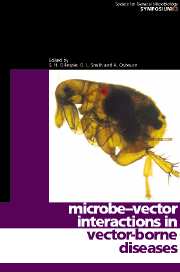Book contents
- Frontmatter
- Contents
- Contributors
- Editors' Preface
- 1 Vector-borne diseases
- 2 Evolution of tick-borne disease systems
- 3 Insect transmission of viruses
- 4 RNA-based immunity in insects
- 5 Specificity of Borrelia–tick vector relationships
- 6 Bunyavirus/mosquito interactions
- 7 How do mosquito vectors live with their viruses?
- 9 Vector competence
- 9 Environmental influences on arbovirus infections and vectors
- 10 Vector immunity
- 11 Transmission of plant viruses by nematodes
- 12 Wolbachia host–symbiont interactions
- 13 Pathogenic strategies of Anaplasma phagocytophilum, a unique bacterium that colonizes neutrophils
- 14 Interactions of Yersinia pestis with its flea vector that lead to the transmission of plague
- 15 Transgenic malaria
- 16 Vaccines targeting vectors
- Index
5 - Specificity of Borrelia–tick vector relationships
Published online by Cambridge University Press: 06 July 2010
- Frontmatter
- Contents
- Contributors
- Editors' Preface
- 1 Vector-borne diseases
- 2 Evolution of tick-borne disease systems
- 3 Insect transmission of viruses
- 4 RNA-based immunity in insects
- 5 Specificity of Borrelia–tick vector relationships
- 6 Bunyavirus/mosquito interactions
- 7 How do mosquito vectors live with their viruses?
- 9 Vector competence
- 9 Environmental influences on arbovirus infections and vectors
- 10 Vector immunity
- 11 Transmission of plant viruses by nematodes
- 12 Wolbachia host–symbiont interactions
- 13 Pathogenic strategies of Anaplasma phagocytophilum, a unique bacterium that colonizes neutrophils
- 14 Interactions of Yersinia pestis with its flea vector that lead to the transmission of plague
- 15 Transgenic malaria
- 16 Vaccines targeting vectors
- Index
Summary
BORRELIA
The genus Borrelia comprises diverse species of spirochaetes that are associated with haematophagous arthropods (Paster et al., 1991; Paster & Dewhirst, 2000). Some Borrelia species are pathogenic for humans or for livestock. Other spirochaete groups with human pathogens are the treponemes, which include the human-restricted agent of syphilis, and the leptospires, which are mostly free-living spirochaetes that infect a wide variety of animals. The spirochaete phylum also contains a number of species that are symbionts of invertebrates, such as molluscs and termites. Borrelia spirochaetes characteristically circulate in the blood of their vertebrate hosts and are transmitted between vertebrates by ticks, with the single, epidemiologically important exception of a louse-borne species. A common strategy of Borrelia spp. for prolonging spirochaetaemia – thus increasing the probability of vector transmission – is avoidance of the immune response through antigenic variation (Barbour & Restrepo, 2000; Barbour, 2002). Most types of Borrelia infections are zoonoses, but humans are the critical reservoirs for at least one species (Barbour & Hayes, 1986; Barbour, 2004).
The number of recognized Borrelia species has more than doubled over the last two decades, in part because cultivation methods improved (Barbour, 1988; Cutler et al., 1994) and technologies like PCR allowed identification and taxonomic classification without being able to culture the organism (Anda et al., 1996; Barbour et al., 1996; Kisinza et al., 2003; Scoles et al., 2001). Table 1 is a list of accepted and tentative species designations, as of early 2004. Borrelia species have been documented in the Palaearctic, Afro-Tropical, Nearctic, Neotropical and Antarctic ecological regions, and some species that use humans or livestock as reservoirs are now cosmopolitan.
- Type
- Chapter
- Information
- Microbe-vector Interactions in Vector-borne Diseases , pp. 75 - 90Publisher: Cambridge University PressPrint publication year: 2004
- 5
- Cited by



